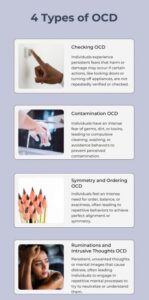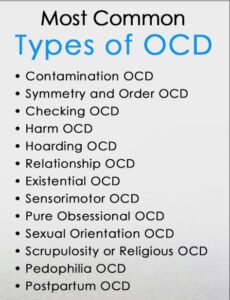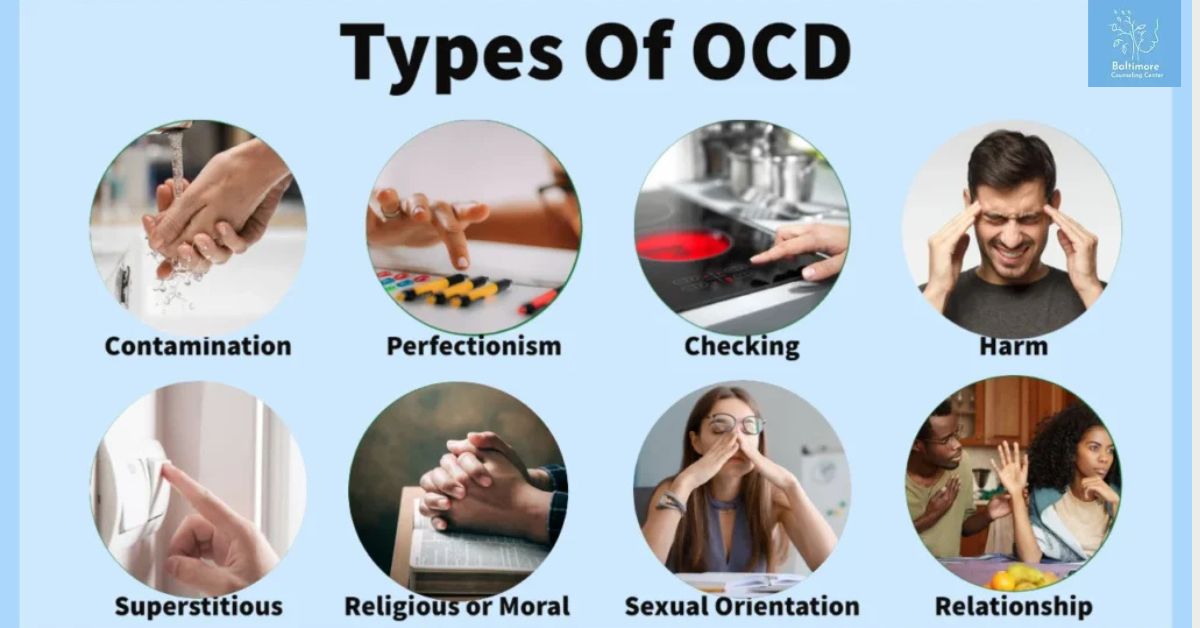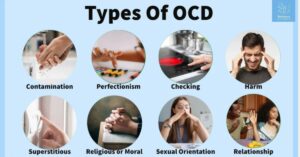Have you ever found yourself stuck in a cycle of repetitive thoughts or actions? If so, you’re not alone.
Understanding the complexities of Obsessive-Compulsive Disorder (OCD) can be overwhelming, but knowing the different types can give you clarity and control. You’ll discover the four distinct types of OCD, each with its unique challenges and characteristics. By the end, you’ll not only be able to identify these types but also gain insights into how they can affect your daily life.
PTSD Treatment
With this knowledge, you’ll be better equipped to manage symptoms or support a loved one facing this condition. Dive in to uncover the intricacies of OCD and empower yourself with the understanding that can make a significant difference.

Types Of Ocd
Obsessive-Compulsive Disorder (OCD) can manifest in different ways. Understanding the types of OCD helps in identifying symptoms and seeking appropriate treatment. Each type has unique characteristics that affect individuals differently. Here, we explore the four main types of OCD, providing insight into their distinct features.
Contamination OCD involves an intense fear of germs, dirt, or illness. Individuals may feel compelled to wash their hands excessively or clean their surroundings constantly. This fear often leads to avoidance behavior, steering clear of places perceived as dirty. Those affected may also worry about spreading germs to others.
Checking OCD is characterized by the need to repeatedly verify things. People may check locks, appliances, or even their own actions to ensure safety. This type of OCD stems from a fear of harm or mistakes. The repeated checking can become time-consuming and interfere with daily life.
Symmetry And Ordering Ocd
Symmetry and ordering OCD involves a compulsion to arrange items in a specific way. Individuals may feel distressed when things are out of place. This OCD type is driven by a need for balance and order. People might spend hours organizing, unable to tolerate asymmetry or disorder.
Intrusive Thoughts Ocd
Intrusive Thoughts OCD features unwanted and distressing thoughts. These thoughts are often violent or taboo. Individuals with this type of OCD may fear acting on these thoughts, leading to anxiety and avoidance. The thoughts are persistent, despite being unwanted and irrational.
Contamination Ocd
Obsessive-Compulsive Disorder, commonly known as OCD, affects millions globally. It manifests in different ways. Among the four primary types, Contamination OCD stands out. This type revolves around the fear of dirt, germs, and illness. Those affected often feel an overwhelming need to clean or avoid places and things they perceive as dirty. Let’s delve deeper into Contamination OCD.
What Is Contamination Ocd?
Contamination OCD involves a persistent fear of being dirty or infected. These fears often lead to compulsive cleaning or avoidance behaviors. This type of OCD can disrupt daily life. It causes stress and anxiety.
Common Symptoms Of Contamination Ocd
- Frequent hand washing
- Avoiding public places
- Obsessive cleaning of personal spaces
- Fear of touching doorknobs or shared surfaces
These actions aim to reduce anxiety. But they often provide only temporary relief.
Impact On Daily Life
Contamination OCD can severely impact life. People may spend hours cleaning. They may avoid social interactions. Simple tasks become stressful.
| Aspect of Life | Impact |
| Social Interactions | Avoidance of gatherings due to fear of germs |
| Work | Difficulty in shared spaces |
| Home | Excessive cleaning routines |
Managing Contamination OCD involves several strategies:
- Therapy sessions such as Cognitive Behavioral Therapy (CBT)
- Mindfulness and relaxation techniques
- Gradual exposure to feared situations
Seeking professional help can make a difference. It helps in managing symptoms effectively.
Hoarding Ocd
Obsessive-Compulsive Disorder (OCD) is a mental health condition characterized by unwanted thoughts and repetitive behaviors. Among its various forms, Hoarding OCD stands out for its intense difficulty in discarding possessions. This type of OCD can significantly impact a person’s living environment and overall quality of life. Understanding Hoarding OCD is crucial for those dealing with or supporting someone experiencing this condition.
Understanding Hoarding Ocd
Hoarding OCD involves a persistent difficulty in parting with possessions. This often stems from a perceived need to save items or distress linked to discarding them. People with Hoarding OCD may accumulate a large number of items, regardless of their actual value.
Symptoms Of Hoarding Ocd
- Difficulty discarding or parting with possessions
- Feeling overwhelmed by clutter
- Living spaces become unusable due to accumulated items
- Emotional distress when considering throwing items away
Impact On Daily Life
Hoarding OCD can disrupt daily life significantly. Rooms become cluttered, making it difficult to use them for their intended purpose. Social interactions may decrease due to embarrassment or shame about one’s living conditions.
Comparison With Other Ocd Types
| Type of OCD | Main Focus |
| Hoarding OCD | Difficulty discarding items |
| Contamination OCD | Fear of germs and contamination |
| Checking OCD | Compulsion to check things repeatedly |
| Symmetry OCD | Need for order and symmetry |
Seeking Help And Treatment
Help is available for those struggling with Hoarding OCD. Cognitive Behavioral Therapy (CBT) is one effective treatment option. It helps individuals challenge their thoughts and change their behaviors related to hoarding.
It’s important to seek professional help to manage Hoarding OCD. Family and friends can play a supportive role by encouraging treatment and understanding the condition.
Checking Ocd
Obsessive-Compulsive Disorder (OCD) affects millions of people worldwide. It comes in different forms, each with its unique challenges. One of the most common types is Checking OCD. This subtype is characterized by the overwhelming need to repeatedly check things to prevent perceived danger or harm. Those who experience Checking OCD might feel trapped in a cycle of checking and anxiety.
What Is Checking Ocd?
Checking OCD involves the persistent urge to check items or situations. People with this condition often fear that something terrible might happen if they don’t verify things repeatedly. This checking behavior can consume hours of their day, impacting daily life.
Common Checking Ocd Behaviors
- Locking Doors: Repeatedly ensuring doors are locked to prevent intrusions.
- Appliances: Constantly checking if appliances are turned off to avoid fire hazards.
- Lights: Checking if lights are off to save electricity and prevent overheating.
- Car Doors: Verifying car doors are locked for security.
Why Checking Ocd Develops
Checking OCD often arises from intense anxiety. Individuals may feel responsible for preventing bad things from happening. This responsibility leads to compulsive checking behaviors. These actions seem rational at first but can quickly become excessive.
Impact On Daily Life
Checking OCD can disrupt daily activities significantly. People might find themselves unable to leave home without performing a series of checks. This cycle can lead to tardiness, stress, and fatigue. Relationships might suffer as well, with loved ones struggling to understand the compulsive behaviors.
Managing Checking Ocd
Effective management strategies exist for Checking OCD. Cognitive Behavioral Therapy (CBT) is one of the most successful treatments. It helps individuals challenge and change their thinking patterns. Medications like SSRIs can also provide relief.
| Strategy | Benefit |
| Cognitive Behavioral Therapy (CBT) | Helps reframe obsessive thoughts. |
| Selective Serotonin Reuptake Inhibitors (SSRIs) | Reduces anxiety and compulsive urges. |
Intrusive Thoughts
Obsessive-compulsive disorder (OCD) is a complex mental health condition. It manifests in various ways, often disrupting daily life. Among the different types of OCD, intrusive thoughts stand out due to their distressing nature. These thoughts are unwanted and often disturbing. They can cause significant anxiety and discomfort. Understanding intrusive thoughts is crucial for anyone dealing with OCD or supporting someone with the condition.
Understanding Intrusive Thoughts
Intrusive thoughts are unwelcome mental images or ideas. They often appear suddenly and can be quite alarming. These thoughts usually involve taboo or fear-inducing subjects. Many people experience them occasionally. For those with OCD, they are persistent and hard to ignore.
The Impact Of Intrusive Thoughts
Intrusive thoughts can lead to extreme anxiety. They make individuals question their morals or sanity. People often feel guilt or shame about these thoughts. Important: Intrusive thoughts do not reflect true intentions or desires. They are merely involuntary mental disruptions.
Coping Strategies For Intrusive Thoughts
- Mindfulness: Staying present helps recognize thoughts as fleeting.
- Cognitive Behavioral Therapy (CBT): This therapy addresses thought patterns directly.
- Professional Help: Consulting a therapist can provide tailored strategies.
- Support Groups: Sharing experiences with others offers comfort and insights.
Common Misconceptions
| Misconception | Reality |
| Intrusive thoughts reflect desires. | They are involuntary and not chosen. |
| Everyone has intrusive thoughts. | Severity and persistence vary greatly. |
| Ignoring them will make them go away. | They often need active management. |
Symmetry And Order
Obsessive-Compulsive Disorder (OCD) is a mental health condition that affects many people worldwide. It involves unwanted thoughts, feelings, or behaviors that drive individuals to repeat certain actions. This condition is divided into four main types, each with unique characteristics. One of these types is Symmetry and Order. People with this type of OCD feel a strong need to have everything arranged in a specific way. This need for perfection can lead to significant stress and anxiety.
What Is Symmetry And Order Ocd?
Symmetry and Order OCD revolves around the need for balance. Individuals may spend hours arranging objects until they feel “just right.” This can involve organizing items by size, color, or alignment. The urge for symmetry can be overwhelming, causing distress if things are out of place.
Common Symptoms
- Rearranging items: Constantly moving objects to achieve a particular order.
- Counting: Repeatedly counting steps, objects, or actions to ensure balance.
- Perfectionism: A need for flawless arrangement and presentation.
- Stress from asymmetry: Feeling anxious if things are uneven or unbalanced.
Impact On Daily Life
Individuals with Symmetry and Order OCD may find daily tasks challenging. Simple activities like setting a table or organizing a desk can take hours. This can lead to frustration and impact relationships and productivity. The need for order can also cause individuals to avoid situations where they can’t control their environment.
- Cognitive Behavioral Therapy (CBT): A therapy that helps change thought patterns.
- Exposure and Response Prevention (ERP): Gradually facing fears and resisting compulsions.
- Mindfulness Techniques: Practicing relaxation and focusing on the present.
- Support Groups: Sharing experiences with others who understand.
Symmetry and Order OCD is a challenging condition. Understanding its symptoms and impacts can help in managing it effectively. Seeking professional help and support is crucial for those struggling with this type of OCD.
Religious Ocd
Obsessive-Compulsive Disorder (OCD) is a mental health condition that affects millions worldwide. It manifests in various forms, each with its unique challenges. Among these is Religious OCD, a type that intertwines spirituality with intrusive thoughts and compulsions. Individuals with Religious OCD often experience intense anxiety related to their beliefs and practices. This can lead to excessive rituals or constant seeking of reassurance about their faith. Understanding this type of OCD is essential for those affected and their loved ones.
Intrusive Religious Thoughts
Individuals with Religious OCD often struggle with intrusive thoughts that conflict with their spiritual beliefs. These thoughts can be distressing and lead to significant anxiety. For example, a person might fear they have committed a sin despite knowing rationally they have done nothing wrong. The fear can become overwhelming, making daily life challenging.
Compulsive Rituals
Compulsive rituals are common in Religious OCD. These rituals may involve repetitive prayers or actions aimed at neutralizing anxiety. The individual might feel compelled to pray multiple times, fearing consequences if they do not. This behavior can take over their routine, impacting social and professional life.
Seeking Reassurance
Many people with Religious OCD seek reassurance from religious leaders or texts. They might frequently ask if certain thoughts or actions are sinful. This constant need for validation can strain relationships with clergy and loved ones.
Impact On Daily Life
The impact of Religious OCD on daily life can be profound. It may lead to isolation as individuals become engrossed in their rituals. Their focus on religious practices can overshadow other aspects of life, such as work and social interactions. Understanding this condition is crucial for providing support and care.
Fear Of Harm
Obsessive-Compulsive Disorder (OCD) affects many people worldwide, causing distress and anxiety. Understanding its types helps in managing and addressing the condition effectively. One of these types is the Fear of Harm. This type is characterized by an overwhelming fear of causing harm to oneself or others. People with this type of OCD might constantly worry about their actions leading to disastrous consequences, even when the chances are slim. This fear can significantly impact daily life and decision-making.
Fear Of Accidental Harm
Individuals with this fear often worry about unintentionally causing harm. They might avoid everyday activities like cooking or driving, fearing potential accidents. For instance, leaving a stove on might cause persistent anxiety about a potential fire. The constant need to check and recheck things becomes a daily ritual.
Fear Of Deliberate Harm
This involves an irrational fear of deliberately harming others. A person might avoid social interactions, worried about aggressive impulses. They may fear losing control and hurting loved ones, despite having no history of violence. Such fears can lead to isolation and distress.
Fear Of Harm Through Negligence
Concern over causing harm due to negligence is common. Individuals worry about not doing enough to prevent potential dangers. For example, they might excessively check locks, fearing intrusions. This can result in exhaustive routines aimed at ensuring safety.
Fear Of Harm To Loved Ones
People with this fear are often anxious about the safety of their family or friends. They might engage in compulsive behaviors to protect them. This includes repetitive prayers or rituals, hoping to avert imagined threats. The constant need to ensure their loved ones’ safety can be exhausting.
Social Anxiety And Ocd
Obsessive-Compulsive Disorder (OCD) is a mental health condition marked by unwanted, recurring thoughts and repetitive behaviors. People with OCD may struggle with different symptoms and experiences. Among the various types of OCD, a significant aspect is its relation to social anxiety. Individuals with OCD may also experience social anxiety, which involves the fear of social situations. This fear can lead to avoidance and distress.
Understanding Social Anxiety And Ocd
Social anxiety is the fear of being judged or embarrassed in social settings. For those with OCD, social anxiety can be particularly challenging. Obsessions might include worries about being perceived negatively by others. This can lead to compulsive behaviors, such as excessive grooming or rehearsing conversations.
The Connection Between Social Anxiety And Ocd
The link between social anxiety and OCD lies in the fear of judgment. People with OCD might feel anxious about their compulsions being noticed. This anxiety can make social interactions more stressful. They may also fear that their obsessive thoughts could lead to embarrassing behaviors.
Common Obsessions And Compulsions
In cases where social anxiety and OCD intersect, the following are common:
- Obsessions: Fear of saying something inappropriate, fear of blushing, fear of being judged.
- Compulsions: Avoiding eye contact, rehearsing conversations, seeking reassurance.
Impact On Daily Life
Both conditions can affect daily life significantly. Social anxiety may cause people to avoid social gatherings. They might miss out on professional or personal opportunities. The compulsion to perform rituals can consume a lot of time and energy. This can lead to a cycle of anxiety and avoidance.
Managing Social Anxiety And Ocd
Managing these conditions involves understanding their impact. Techniques like Cognitive Behavioral Therapy (CBT) can be effective. CBT helps in challenging negative thoughts and reducing compulsive behaviors. Mindfulness and relaxation techniques can also help in managing anxiety.

Diagnosis And Treatment
Obsessive-Compulsive Disorder (OCD) affects millions worldwide, disrupting daily life with intrusive thoughts and compulsive behaviors. Understanding its various types—Contamination, Symmetry, Harm, and Hoarding—can help in diagnosing and treating it effectively. This section sheds light on how professionals diagnose these types and the treatments available to manage symptoms.
Diagnosis Of Ocd Types
Diagnosis begins with a thorough evaluation. Professionals look for patterns in thoughts and behaviors. They ask about obsessions and compulsions affecting daily life. These assessments often include:
- Structured interviews
- Self-report questionnaires
- Observation of behavior
Each OCD type has distinct characteristics. Recognizing these helps in tailoring the treatment. For instance, someone with contamination OCD may exhibit excessive cleaning habits.
Treatment Options
Effective treatment combines therapy and medication. Cognitive Behavioral Therapy (CBT) is popular. It helps change thought patterns. Exposure and Response Prevention (ERP) is a part of CBT. It involves facing fears without performing rituals.
Medications like SSRIs can also be prescribed. These help reduce anxiety and obsessive thoughts. They are often used alongside therapy for best results.
Behavioral Therapy
Behavioral therapy focuses on altering actions. It encourages patients to confront fears. Over time, this reduces anxiety. The therapy is structured and goal-oriented. Patients learn to manage their responses to compulsions.
Medication
Medications are prescribed based on individual needs. SSRIs are common. These medications balance chemicals in the brain. They help reduce symptoms. Doctors monitor progress and adjust dosage as needed.
Combining Treatments
A combination of therapy and medication often yields the best results. Patients report significant improvement. This approach addresses both mental and physical aspects of OCD. Regular follow-ups ensure treatments remain effective.
Coping Strategies
Obsessive-Compulsive Disorder (OCD) can significantly impact daily life. Recognizing the four types of OCD is crucial for understanding how they manifest. These include checking, contamination, symmetry and order, and intrusive thoughts. Each type demands unique coping strategies to manage symptoms effectively. Implementing practical techniques can alleviate distress and promote mental well-being.
Cognitive Behavioral Therapy (cbt)
Cognitive Behavioral Therapy is a structured approach that targets unwanted thoughts and behaviors. It involves identifying irrational beliefs and replacing them with healthier patterns. Therapy sessions focus on exposure and response prevention. This helps reduce anxiety by confronting fears in a controlled environment.
Mindfulness Techniques
Mindfulness helps in grounding oneself in the present moment. Practices such as deep breathing and meditation can calm the mind. They promote awareness of thoughts without judgment. Regular mindfulness exercises can reduce the intensity of OCD symptoms over time.
Building A Support Network
A strong support network can provide encouragement and understanding. Family members, friends, or support groups can offer valuable assistance. Sharing experiences and coping methods can empower individuals. It helps in feeling less isolated and more connected.
Healthy Lifestyle Choices
- Balanced Diet: Consuming nutritious foods supports mental health.
- Regular Exercise: Physical activity releases endorphins, improving mood.
- Adequate Sleep: Restful sleep helps in managing stress.
These lifestyle choices contribute to overall well-being and can mitigate OCD symptoms.
| Strategy | Benefits |
| Cognitive Behavioral Therapy | Reduces irrational thoughts |
| Mindfulness Techniques | Enhances focus and calmness |
| Building a Support Network | Encourages shared experiences |
| Healthy Lifestyle Choices | Boosts mental health |
Frequently Asked Questions
What Is The Hardest Form Of Ocd?
Pure Obsessional OCD, or Pure O, is often considered the hardest form. It involves intrusive, unwanted thoughts without visible compulsions. Sufferers experience mental rituals, causing significant distress. This form can be challenging to diagnose due to the absence of physical compulsions, making it particularly difficult to manage.
Which Type Of Ocd Is Most Common?
The most common type of OCD involves contamination fears and compulsive cleaning or washing. People often feel anxious about germs or dirt. This type can significantly impact daily life, causing stress and disruption. Understanding it helps in seeking appropriate treatment and support.
How Do You Tell If Someone Has Ocd?
OCD symptoms include repetitive behaviors, intrusive thoughts, and compulsions impacting daily life. Look for excessive hand washing, counting, or checking. Individuals may experience distress or anxiety from unwanted thoughts, seeking to alleviate them through specific actions. Consulting a mental health professional can provide a proper diagnosis and support.
Conclusion
Understanding OCD types helps in recognizing symptoms early. Each type is unique. So, awareness is key. This knowledge aids in seeking proper treatment. Support from family and friends is crucial. It makes a significant difference. Remember, OCD is manageable with the right help.
Professional guidance often leads to improvement. Explore resources and support groups. They offer valuable assistance. Knowledge empowers you to face challenges. It provides clarity and hope. Always prioritize mental health. It deserves attention and care. Keep learning and stay informed.
Your journey to understanding OCD is important. Take one step at a time.


